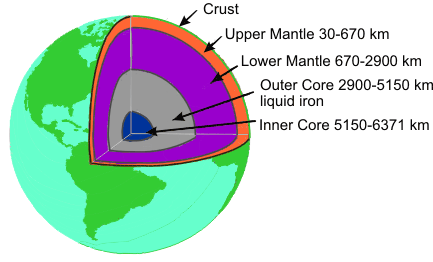Generation of the Earth's magnetic field
Although the Earth's magnetic field resembles that of a bar magnet we must find another explanation for the field's origin. Permanent magnets cannot exist at the temperatures found in the Earth's core. We also know that the Earth has had a magnetic field for hundreds of millions of years. We cannot, however, simply attribute the existence of the present geomagnetic field to some event in the distant past. Magnetic fields decay, and we can show that the existing geomagnetic field would disappear in about 15,000 years unless there were a mechanism to continually regenerate it.
Many mechanisms have been postulated to explain how the magnetic field is generated, but the only one that is now considered plausible is analogous to a dynamo, or generator - a devise for converting mechanical energy to electrical energy. To understand how a dynamo would work in the context of the Earth, we need to understand the physical conditions in the Earth's interior.
The Earth is composed of layers: a thin outer crust, a silicate mantle, an outer core and an inner core. Both temperature and pressure increase with depth within the Earth. The temperature at the core mantle boundary is roughly 4800° C, hot enough for the outer core to exist in a liquid state. The inner core, however, is solid because of increased pressure. The core is composed primarily of iron, with a small percentage of lighter elements. The outer core is in constant motion, due both to the Earth's rotation and to convection. The convection is driven by the upward motion of the light elements as the heavier elements freeze onto the inner core.

Earth's interior
The actual process by which the magnetic field is produced in this environment is extremely complex, and many of the parameters required for a complete solution of the mathematical equations describing the problem are poorly known. However, the basic concepts are not difficult. For magnetic field generation to occur several conditions must be met:
- there must be a conducting fluid;
- there must be enough energy to cause the fluid to move with sufficient speed and with the appropriate flow pattern;
- there must be a "seed" magnetic field.
All these conditions are met in the outer core. Molten iron is a good conductor. There is sufficient energy to drive convection, and the convective motion, coupled with the Earth's rotation, produce the appropriate flow pattern. Even before the Earth's magnetic field was first formed magnetic fields were present in the form of the sun's magnetic field. Once the process is going, the existing field acts as the seed field. As a stream of molten iron passes through the existing magnetic field, an electric current is generated through a process called magnetic induction. The newly created electric field will in turn create a magnetic field. Given the right relationship between the magnetic field and the fluid flow, the generated magnetic field can reinforces the initial magnetic field. As long as there is sufficient fluid motion in the outer core, the process will continue.